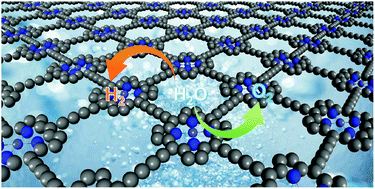Crystalline porphyrin-based graphdiyne for electrochemical hydrogen and oxygen evolution reactions†
Abstract
Two-dimensional graphdiyne (GDY) materials bearing functional photoelectric units have gained much attention due to their unique 2D structure and the sp hybridized carbon. Herein, we prepared a crystalline porphyrin-based graphdiyne through Glaser–Hay coupling reactions. The accurate structure information was acquired through the SAED analysis and simulation. By simply treating with a Co2+ solution, the Co-loaded porphyrin-graphdiyne (CoPor-GDY) could be easily obtained and can serve as a bifunctional electrocatalyst for the hydrogen evolution reaction (HER) and the oxygen evolution reaction (OER) in alkaline solution. Numerous electrocatalytic sites from Co-porphyrin moieties cooperate with the rapid transport of the butadiyne groups. In addition, the extended 2D porous structure of CoPor-GDY could provide effective transporting channels for the diffusion of small molecules and finally lead to efficient catalytic performance. CoPor-GDY exhibited an overpotential of 308 mV at 10 mA cm−2 and a Tafel slope of 68 mV dec−1 for the HER and an overpotential of 400 mV at 10 mA cm−2 and a Tafel slope of 129 mV dec−1 for the OER. This work explored a new route for the design of a non-noble metal-coordinated GDY analogue electrocatalyst for new energy devices.

- This article is part of the themed collection: Graphyne


 Please wait while we load your content...
Please wait while we load your content...